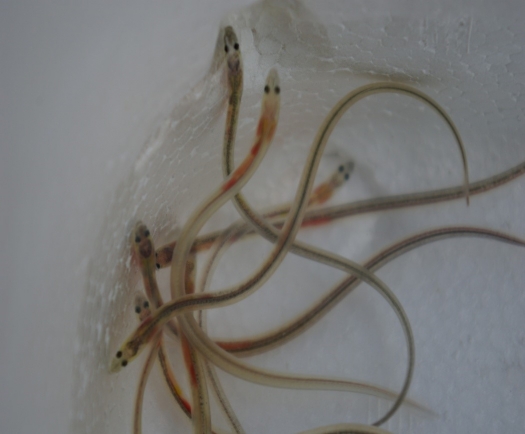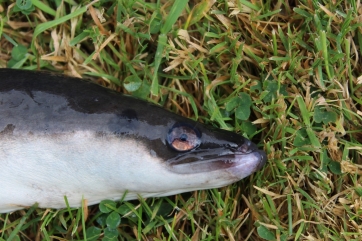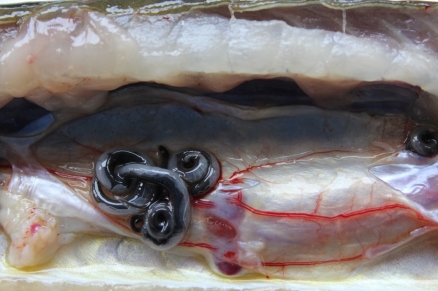In 2013, we published a special report called "What's happening at the lock?" about the renewal of Teston Lock. It explained the importance (especially to eels) of the fish passes that had been installed at Teston as part of the works, but also mentioned that until East Farleigh lock had a fish pass as well, the fish would still be unable to migrate freely up or downstream. Now that work is complete! We asked our local fisheries expert Dr Bernice Brewster why these passes are so important in the battle to save the European eel.
Here is her fascinating and informative reply:
Fish passes – a r’eel’y good idea
Freshwater fish migrate up and downstream constantly, for avoiding predators, feeding and spawning but locks and weirs are a barrier to these movements. The recent construction of a fish pass at Teston Lock and the current construction of another at East Farleigh will allow many different species of fish to move freely up and down the Medway, most importantly it will allow the free passage of the European eel to complete its’ life cycle.
Between 1904 and 1922, the Danish Oceanographer, Johann Schmidt tracked migrating European eels across the Atlantic to the Sargasso Sea, just west of the Caribbean, which he presumed to be the spawning site. To this date scientists are not entirely certain the Saragasso is the spawning destination for sexually mature eels, none the less, these fish undertake a migration exceeding 7000km (4,300 miles). Spawning of eels in the wild remains undocumented but the larvae, known as ‘leptocephali’ (small head) and originally described as a separate species of fish, undertake the return migration to Europe. What is so remarkable is the tiny leptocephali are still no more than a few centimetres (less than an inch) when they arrive at the English river estuaries between February and March to begin their upstream migration as ‘glass eels’ (see pic below).

The glass eels feed and grow to become small eels known as ‘bootlaces’, then as they get bigger the underneath becomes a yellow or bronze colour and they are termed ‘yellow eels’. The yellow eels spend between 15 – 30 years feeding and growing in the rivers before the final transformation into ‘silver eels’.
Silver eels begin the downstream migration towards the sea but once they have become silvered, they no longer feed. The riverine silver eels are pre-sexually mature, sexual maturity taking place once the fish have begun their oceanic migration.

For hundreds of years the eel formed the staple diet for many people in England and the trade in eels with our European neighbours was extremely lucrative, with Ely Cathedral being built from the proceeds.
Since the turn of the 20th Century, the popularity of eels as a food source has declined, although glass eels are still caught on the Rivers Severn and Parrot but most are destined to be sold to China, where they are regarded as a delicacy.
[Editor’s note: The value of these tiny eels is enormous. Athough their collection is regulated by licence, their value encourages criminality. A man was recently arrested for attempting to smuggle 200kgs of glass eels through Heathrow, which were valued at £1.2m!].
Over the last 40 years, the numbers of glass eels returning to our shores has spiralled into serious decline. The European eel is now listed on the International Union for the Conservation of Nature (IUCN) Red Data list as ‘critically endangered’, which means the eel is in danger of extinction.
But what has led us to this parlous state, where such an enigmatic animal has declined in numbers to the point of extinction? Our oceans are now heavily polluted with polyaromatic hydrocarbons, polychlorinated biphenyls, pesticides, fertilizers, untreated sewage and microplastics to name just a few and through which the tiny leptocephali must make their way to our rivers, absorbing these noxious chemicals en route.
In the 1980’s someone had the good idea of importing into Europe Japanese eels, a completely different species of eel, native to the Far east. The phrase ‘as slippery as an eel’ is no understatement and of course, some of the Japanese eels escaped but they were infected with a round worm parasite (see below) which feeds on the swimbladder (a buoyancy organ which helps fish to float at any water depth without expending any energy). The Japanese eel and the worm have evolved together and it causes little pathology to the native host.

But the European eel has no resistance to this non-native parasite and it has spread like wild-fire through our eel populations. In the European eel the parasite destroys the swimbladder and the fish is unable to swim efficiently meaning the infected eels cannot undertake their spawning migration. Infected eels have become susceptible to other diseases, including viruses which may result in mass mortalities.
So how will the fish passes help in our bid to save the eel from extinction? Since the industrial revolution we have been barricading and impounding rivers which become a barrier to migration for the eels. The tiny glass eels may have been able to negotiate some of the barriers but then the growing eels become landlocked and once silvered have been unable to migrate and therefore die. The introduction of fish passes will enable the eels free passage along the rivers and hopefully help to save the eel before we reach the point of no return. So, three cheers for the work currently being undertaken to create a fish pass at East Farleigh, following the one at Teston.
Bernice Brewster BSc, PhD
PS There is currently a project underway to spawn eels using aquaculture techniques, it hasn’t been especially successfully, larvae only living to 20 days but www.pro-eel.eu has a super video of an eel larva swimming.







Make A Comment
Comments (3)